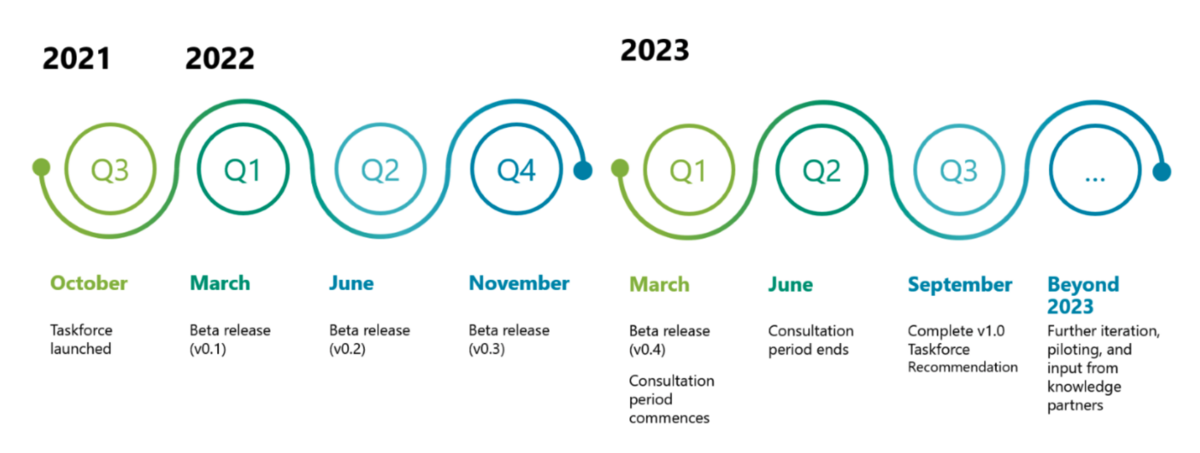Pioneering framework to address nature-related risks is ready to pilot

Developing strategies for, and reporting on, carbon reduction has become mainstream, but organisations have lacked a robust, science-led equivalent for confronting biodiversity loss. How can companies draw a link between changes to nature and the associated risks to and from their value chains? The Taskforce on Nature-related Financial Disclosures (TNFD) framework provides a comprehensive and flexible process for companies to make a start.
Currently undergoing an iterative development process, the Taskforce’s final beta version (v0.4) is ready for companies to begin piloting. The Biodiversity Consultancy (TBC) has not only contributed to the design of the TNFD framework and its associated guidance, but is also piloting the process to develop robust nature strategies for corporate clients.
In the process of preparing for TNFD-aligned reporting, companies will, by design, also be well-equipped to comply with emerging regulatory standards such as the Global Reporting Initiative (GRI) and EU Corporate Sustainability Reporting Directive (CSRD). Embedded in the TNFD framework is also a process to develop a comprehensive nature strategy and set science-based targets in line with Science-based Targets for Nature (SBTN).
The TNFD framework has come to light at a time of remarkable societal, intergovernmental, and private sector momentum to protect and restore nature. A growing body of research has highlighted the business and finance sector’s immense dependence on natural ecosystems, which in turn is a major driver of natural resource extraction and biodiversity loss.
Moreover, these losses are approaching irreversible thresholds that could trigger collapses in ecological and economic systems, with WEF ranking biodiversity loss and ecosystem collapse as a top global risk. These significant operational, market and societal risks have consequently accelerated momentum to quantify, assess, and mitigate nature-related risks.
The Biodiversity Consultancy supported the development of TNFD. Get in touch to explore how your organisation could use the new framework.
The TNFD: shifting global financial flows towards nature positive outcomes
The TNFD is a market-led initiative launched in 2021 that aims to deliver a risk management and disclosure framework for organisations to report and act on evolving nature-related risks. Through its disclosure framework and engagement with the finance and corporate sectors, the TNFD ultimately aims to support a shift in global financial flows away from nature-negative outcomes and toward nature-positive1 outcomes.
The TNFD aims to drive alignment with the emerging global reporting baseline and adjacent assessment frameworks, such as the International Sustainability Standards Board (ISSB) and SBTN respectively. It also maintains a close connection to related environmental reporting frameworks such as the Taskforce on Climate-related Financial Disclosures (TCFD).
The v0.4 release concludes a series of four beta versions of the disclosure between March 2022 to 2023. Following a consultation period and pilot testing, the final disclosure recommendations and metrics will be released in September 2023 (Figure 1).

The TNFD framework: Nature-related risks and opportunity assessment
The TNFD maintains a four-pillar disclosure recommendation structure identical to that of the Taskforce on Climate-related Financial Disclosures (TCFD), an analogous initiative focusing on climate issues. The reporting pillars of Governance, Strategy, Risk Management and Metrics & Targets encompass a full spectrum of dependency, impact, risk, and opportunity recommended disclosures (Figure 2).
The disclosure process facilitates the development of internal processes and data management structures that are aimed towards managing nature-related risks and opportunities. It is accompanied by the TNFD’s LEAP (Locate, Evaluate, Assess, & Prepare) approach, which offers step-by-step guidance on achieving this transformational change.
Companies who have already undertaken biodiversity and nature-related risk and opportunity assessments separately from the LEAP process do not need to apply LEAP to produce their TNFD disclosures – but may instead use it as a reference to organise and prepare relevant information for the reporting process.
| Governance | Strategy | Risk & Impact Management | Metrics & Targets |
|---|---|---|---|
| Disclose the organisation's governance around nature-related dependencies, impacts, risks and opportunities | Disclose the actual and potential impacts of nature-related dependencies, impacts, risks and opportunities on the organisation's businesses, strategy and financial planning where such information is material. | Disclose how the organisation identifies, assesses and manages nature-related dependencies, impacts, risks and opportunities. | Disclose the metrics and targets used to assess and manage relevant nature-related dependencies, impacts, risks and opportunities where such information is material. |
| <b>Recommended disclosures</b> | <b>Recommended disclosures</b> | <b>Recommended disclosures</b> | <b>Recommended disclosures</b> |
| A. Describe the board's oversight of nature-related dependencies, impacts, risks and opportunities | A. Describe the nature-related dependencies, impacts, risks and opportunities the organisation has identified over the short, medium and long term. | A. (i) Describe the organisation's processes for identifying and assessing nature-related dependencies, impacts, risks and opportunities in its direct operations. | A. Disclose the metrics used by the organisation to assess and manage material nature-related risks and opportunities in line with its strategy and risk management process. |
| B. Describe management's role in assessing and managing nature-related dependencies, impacts, risks and opportunities. | B. Describe the effect nature-related risks and opportunities have had and may have on the organisation's businesses, strategy and financial planning. | A. (ii) Describe the organisation's approach to identifying nature-related dependencies, impacts, risks and opportunities in its upstream and downstream value chain(s) and financed activities and assets. | B. Disclose the metrics used by the organisation to assess and manage dependencies and impacts on nature. |
| C. Describe the resilience of the organisation's strategy to nature-related risks and opportunities, taking into consideration different scenarios. | B. Describe the organisation's processes for managing nature-related dependencies, impacts, risks and opportunities and actions taken in light of these processes. | C. Describe the targets and goals used by the organisation to manage nature-related dependencies, impacts, risks and opportunities and its performance against these. | |
| D. Disclose the locations where there are assets and/or activities in the organisation's direct operations, and upstream and/or downstream and/or other financed where relevant, that are in priority areas. | C. Describe how processes for identifying, assessing and managing nature-related risks are integrated into the organisation's overall risk management. | ||
| D. Describe how affected stakeholders are engaged by the organisation in its assessment of, and response to, nature-related dependencies, impacts, risks and opportunities. | |||
Figure 2. The TNFD's draft disclosure recommendations (v0.4 beta framework release in Mar 2023)
A voluntary framework supporting mandatory disclosure requirements
Though the TNFD framework is currently voluntary, various factors are pointing to its mainstream adoption to comply with emerging sustainability disclosure regulations.
For example, the EU’s Environmental and Sustainability Reporting standards (ESRS), which are the criteria upholding the recently implemented CSRD, explicitly recommends that companies follow the TNFD LEAP process to identify material nature-related impacts, risks, and opportunities.
The nature-climate nexus is another tailwind that is accelerating the uptake of the TNFD framework. The TNFD was formed, in part, as response to the corporate sector’s successful reception of the TCFD’s climate-related risk disclosure framework. With the rapid integration of TCFD into regulation across different markets2, the TNFD may likely follow a similar accelerated trajectory from voluntary to mandatory.
An ideal time to get involved
Given the TNFD’s alignment with TCFD and various nature-related reporting frameworks, companies have chosen to use this framework to facilitate their process of identifying, evaluating, and reporting on their nature-related risks. Some have already begun producing joint TNFD and TCFD reports as part of their broader sustainability risk management and reporting strategy.3
While the TNFD framework is not mandatory, it is advised that companies prepare to disclose nature-related risks sooner rather than later. Opting to engage with the TNFD framework this year – particularly prior to the launch of the full recommendations in September 2023 – gives companies ample time to identify and prioritise the relevant resourcing and data requirements to embark on their nature strategy journey.
Companies that already have established a biodiversity or nature strategy do not need to start anew in order to fit the TNFD’s framework. Rather, the framework provides an opportunity to identify further areas of development towards a robust nature strategy and can externally signal a proactive stance towards biodiversity risk management.
The Biodiversity Consultancy & TNFD
The Biodiversity Consultancy has been involved with the TNFD across different stages of the framework development, such as:
- Contributor to the beta framework development
- Co-authors of the TNFD’s guidance for biome-specific metrics
- Technical partner for the Metrics & Targets workstream
- Member of the TNFD Data Catalyst
- Facilitators of beta framework piloting for private sector companies
Please get in touch with us if you are interested in exploring the TNFD framework. We can help you get started on your journey by:
- Supporting training and workshops about TNFD and nature-related risks to build a holistic understanding of the important elements through a corporate lens
- Performing data-driven analyses to quantitatively identify and assess nature-related dependencies and impacts in alignment with the LEAP framework, then evaluating relevant risks and opportunities
- Developing a TNFD-aligned corporate nature strategy and preparing for external reporting on nature-related risks disclosures
Categories: Financial Services, Insight
Make Nature Your Business
Find out how you can make nature your business.
